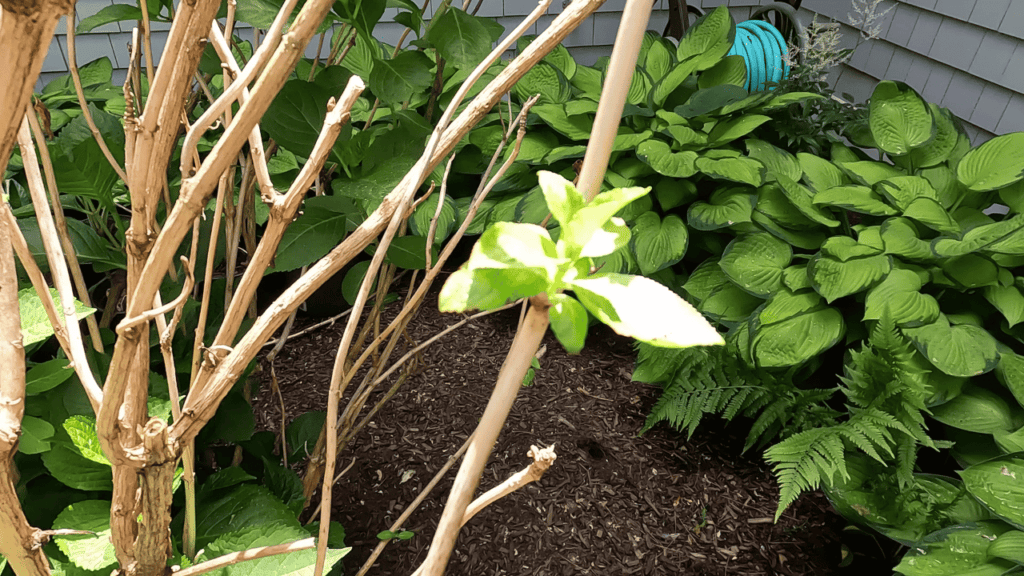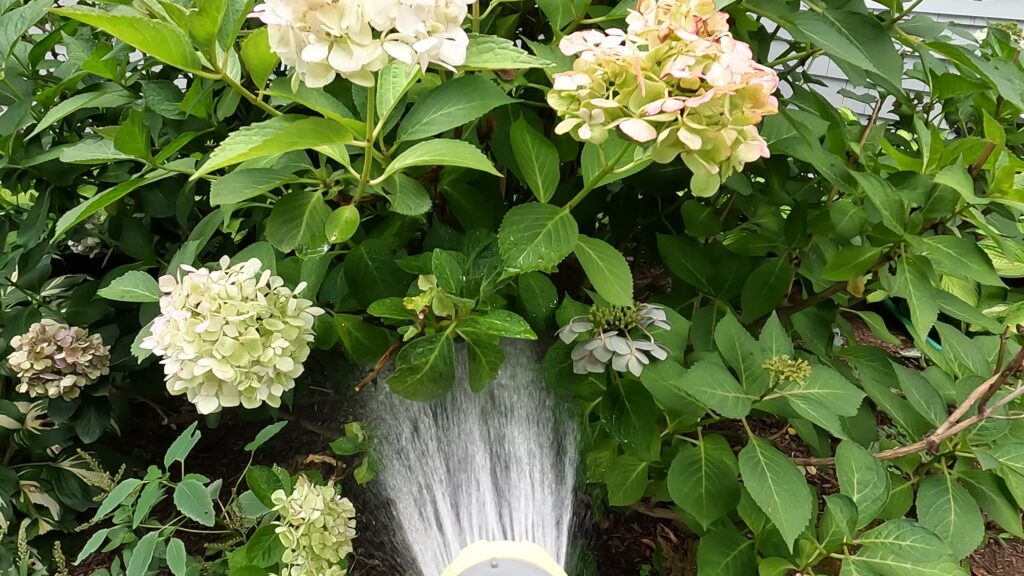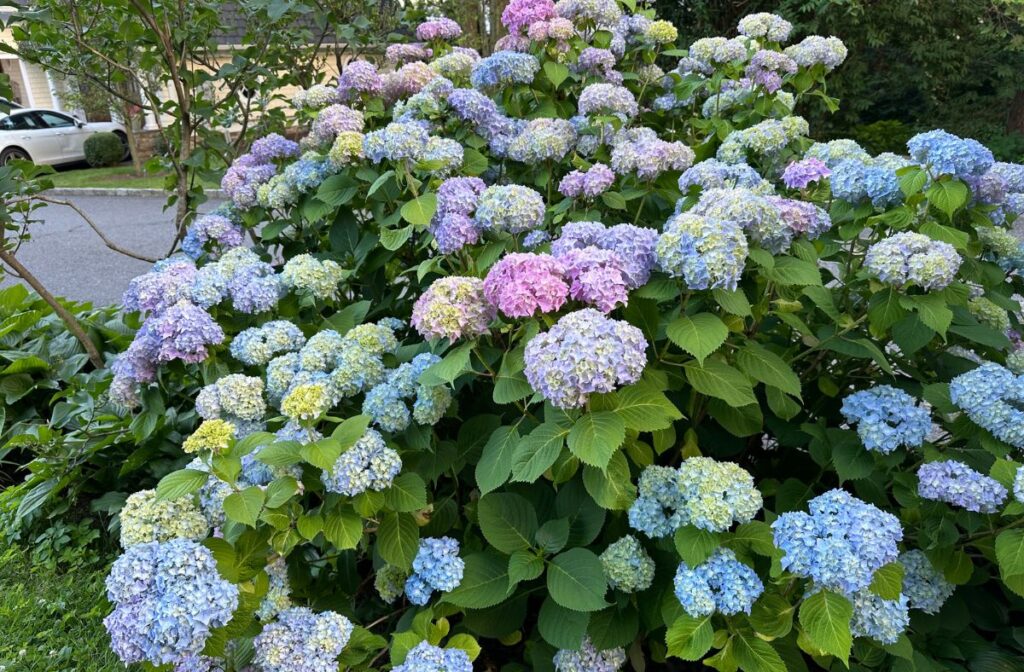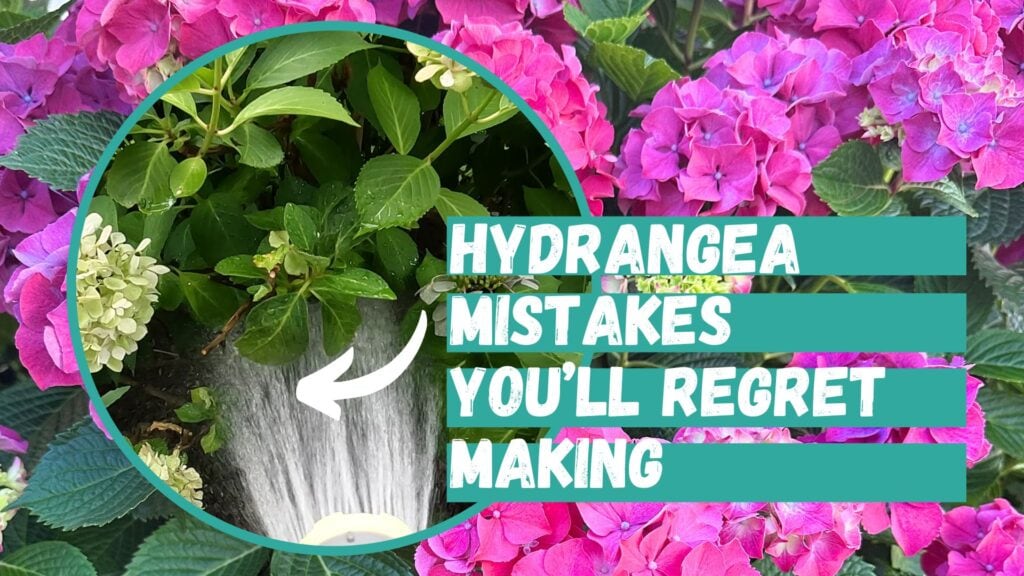Are you tired of plants that require constant attention? Then you’re a lazy gardener like me. That’s why I love hydrangeas.
Hydrangeas are perennial flowering shrubs that practically grow on auto-pilot once established, producing gorgeous blooms year after year.

But, there’s a catch – there are planting requirements that you need to get right, otherwise you may not see the results you’re hoping for.
Below, we’ll go over the top hydrangea planting mistakes to avoid so you can enjoy a stunning garden with minimal effort.
Hydrangea Planting Mistakes
1. Too Much Sun
Hydrangeas are shade-loving plants. But there is a balance: while they don’t do well if it’s too sunny, they also won’t do well if there is too much shade.
If you plant them where there is too much sun, they will wilt and will need more care.
You really can’t be a lazy gardener if you plant your hydrangea in a spot with too much sun. That’s because you will need to water it more frequently.
To get the best out of your hydrangeas, aim to plant them in a location that gets morning sun and afternoon shade.
However, if you live in the South, you’ll need to give them more shade. If you’re in the northeast, like me here in Connecticut, a little bit of sun will do them good.
Try to find a spot where your hydrangeas will get 4-6 hours of sun. Just remember, if you plant them in a super shady area, they will not thrive and bloom as well.

2. Pruning Mistakes
One of the biggest mistakes gardeners make is pruning their hydrangeas incorrectly. First of all, hydrangeas don’t really require pruning. They’ll do just fine and bloom the following year without any pruning.
But, if you do want to tidy them up a bit, you need to be extremely careful when pruning. It’s important not to cut off the buds since these are the flowers for the next year.
If you accidentally cut them off, you won’t have any flowers the following year.

Trust me, I learned this the hard way when I pruned off all the buds, and my hydrangeas did not flower the next year.
To be honest, my advice is not to even bother pruning hydrangeas. Leave them alone, you might accidentally cut off the flower buds. When it comes to hydrangeas, it’s best to be a lazy gardener and let them be!
If you want to learn more about pruning hydrangeas. Check out this article about pruning hydrangeas– which hydrangeas are new wood and old wood hydrangeas and whether or not to prune.
3. Over Fertilizing
Another mistake that gardeners make is they over fertilize their hydrangeas. If you’re fertilizing your hydrangeas every week, that’s really excessive and is actually bad for your plant.
All you really need to do is fertilize your hydrangeas twice a year- once in the spring and another time in mid-July when your hydrangeas are in bloom.

If you forget to fertilize, don’t worry; your hydrangea will be okay and will still bloom. To be honest, I’ve been guilty of forgetting to fertilize my hydrangeas and my hydrangeas still bloomed nicely.
4. Overwater
Overwatering your hydrangeas is a common mistake. They don’t really need a lot of water to thrive. In fact, too much water can lead to root rot. It can also lead to fewer blooms and yellowing leaves.

If it’s been raining a lot, don’t water too much. Once a week should be fine.
But if there is a heatwave, then you can increase your watering frequency to a few times a week. It really depends on where you live and the weather. But the key is to do less watering. If you’re unsure, less water is better than more.
5. Underwater
When it comes to hydrangeas, not watering enough is also an issue. I’ve been guilty of that. For me, in Connecticut, I find, once a week watering is enough.
But if there is a drought, I need to increase it to a few times a week or even every day. Otherwise, I start to see my hydrangeas droop and look wilted. And it won’t flower as much.
I had one summer when I was just too busy working and traveling and rarely watered my hydrangeas. They thrived, but they didn’t flower, and the blooms were sparse.

The following year, I watered my hydrangeas once a week without skipping a week, and they bloomed nicely.
Of course, if you live in the south where summers are really hot, you won’t be able to get away with once a week watering.
You need to experiment and see what works for you and find the optimal watering frequency for your hydrangea. The nice thing about growing hydrangeas is they are forgiving, it’s hard to kill hydrangeas!
6. Don’t Plant Hydrangeas Where It’s too Cold
If you live in USDA zones 1 and 2, which is Alaska, that’s way too cold for your hydrangeas. It won’t survive.

7. Planting Your Hydrangeas Under Trees
Many people make the mistake of planting their hydrangeas under trees, thinking that it’s okay since hydrangeas like shade. However, planting your hydrangeas directly under a tree can result in it not growing as well.
This is because it has to compete with the roots of the tree for water, and it also won’t get enough sunlight because it’s getting too much shade under the tree.
It will still live, but you’ll end up with a hydrangea plant that might not bloom and will look weak. That’s why it’s best to avoid planting your hydrangeas under trees and instead choose a location that provides adequate sunlight and water.

8. Wrong PH
Although this is a minor mistake- you do need to get the soil PH right for your hydrangea to grow nicely. It’s quite sensitive to the soil PH level.
If you have blue hydrangeas, plant them in acidic soil, and you will get beautiful blue flowers. If you have pink hydrangeas, it’s best to plant it in alkaline soil.
But of course, if you don’t get the PH right, your hydrangeas will do just fine. It’s a very forgiving plant- that’s why I love it for lazy gardeners like me!

9. Poor Soil Drainage
Hydrangeas are happiest in well-draining soil. If you plant them in heavy clay soil, it may not grow as well because of the poor drainage. To improve the soil, you can add gypsum.
But, if you’re not sure what type of soil you have, don’t worry. Your hydrangeas will still live and bloom beautifully- just not to their optimal level.
10. Plant the correct hydrangea variety
If you want your hydrangeas to do well with little to no effort on your part, you should start off with the right type of hydrangeas.
Although, hydrangeas are pretty versatile and can survive in zones 3 to 9. You should still plant the variety of hydrangea that does best in your zone.
For example, if you live in zones 3 to 4, you should plant hydrangeas that are tolerant to the cold.
The best are the hydrangeas that grow on new wood, so there’s no need to worry about the freezing winter killing off the flower buds.

The best is to plant panicle hydrangeas. Anabelle hydrangeas will do well in zones 3 to 4. Zones 3-4 are the northern midwest states such as North Dakota, Minnesota, Wisconsin and Montana,
For zones 5, which covers parts of New York, New Hampshire, Maine, Vermont, you have more options. Oakleaf hydrangeas is a good one.
In zone 6, the best is to plant panicle hydrangeas. Zones 6 includes the Midwest states such as Ohio, Indiana, Missouri, Kansas.
And in zone 7, which is where I live in Connecticut and neighboring states like New Jersey, Pennsylvania, Virginia, Maryland, Tennessee, big leaf hydrangeas does well.

In zone 8, which includes the Carolinas, Georgia, Texas, big leaf hydrangea will grow beautifully there. Smooth and Oakleaf hydrangeas will also do well in zone 8.
For zone 9, in Florida and California, you need hydrangeas that can tolerate hot weather. Oakleaf, big leaf and smooth hydrangeas will grow well but you will have to water more frequently in zone 9 for them to bloom nicely.
Check out my article on how to easily propagate hydrangeas from stem cutting! That’s right, I just snip off a piece and stem and literally plant them in the soil. It’s so easy.

Get Your FREE Hydrangea Care Tracker Printable

Sign up once and you will get access to ALL exclusive content on this website. After unlocking the printable, just save the printable image and then print it. Use it to keep track of your hydrangea care! I hope you like it!


